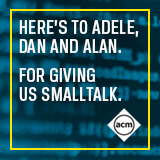Stephen V. Cantrill - Computers in Patient Care: The Promise and the Challenge
A 29-year-old female from New York City comes in at 3 a.m. to an ED (emergency department) in California, complaining of severe acute abdominal pain that woke her up. She reports that she is in California attending a wedding and that she has suffered from similar abdominal pain in the recent past, most recently resulting in an appendectomy. The emergency physician performs an abdominal CAT scan and sees what he believes to be an artifact from the appendectomy in her abdominal cavity. He has no information about the patient’s past history other than what she is able to tell him; he has no access to any images taken before or after the appendectomy, nor does he have any other vital information about the surgical operative note or follow-up.
Samantha Kleinberg, Bud Mishra - Metamorphosis: the Coming Transformation of Translational Systems Biology
One morning, as Gregorina Samsa was waking up from anxious dreams, she discovered that she had become afflicted with certain mysterious flu-like symptoms that appeared without any warning. Equally irritating, this capricious metamorphosis seemed impervious to a rational explanation in terms of causes and effects. "What’s happened to me?" she thought. Before seeing a doctor, she decided to find out more about what might ail her. She logged on to a Web site where she annotated a timeline with what she could remember. Since March, she’d had more headaches than usual, and then in April she had begun to experience more fatigue after exercise, and as of July she had also experienced occasional lapses in memory.
James C Phillips, John E. Stone - Probing Biomolecular Machines with Graphics Processors
Computer simulation has become an integral part of the study of the structure and function of biological molecules. For years, parallel computers have been used to conduct these computationally demanding simulations and to analyze their results. These simulations function as a "computational microscope," allowing the scientist to observe details of molecular processes too small, fast, or delicate to capture with traditional instruments. Over time, commodity GPUs (graphics processing units) have evolved into massively parallel computing devices, and more recently it has become possible to program them in dialects of the popular C/C++ programming languages.
Matthew T. Dougherty, Michael J. Folk, Erez Zadok, Herbert J. Bernstein, Frances C. Bernstein, Kevin W. Eliceiri, Werner Benger, Christoph Best - Unifying Biological Image Formats with HDF5
The biological sciences need a generic image format suitable for long-term storage and capable of handling very large images. Images convey profound ideas in biology, bridging across disciplines. Digital imagery began 50 years ago as an obscure technical phenomenon. Now it is an indispensable computational tool. It has produced a variety of incompatible image file formats, most of which are already obsolete.
Comments
(newest first)
Fascinating
I had the honor to look look at Anton and speak with the engineering team in some detail. IMHO: Anton is an amazing piece of technology, made by brilliant people. The system architecture and development path are more than well throughout out. The prospects for substantial improvements is mostly an engineering exercise and there is still significant room for algorithmic improvements. Given all this and new technologies, there are likely additional paradigm shifts in performance, convenience and capacity to be expiated.
How is Anton doing in the filed?
What progress is there on Anton II?





